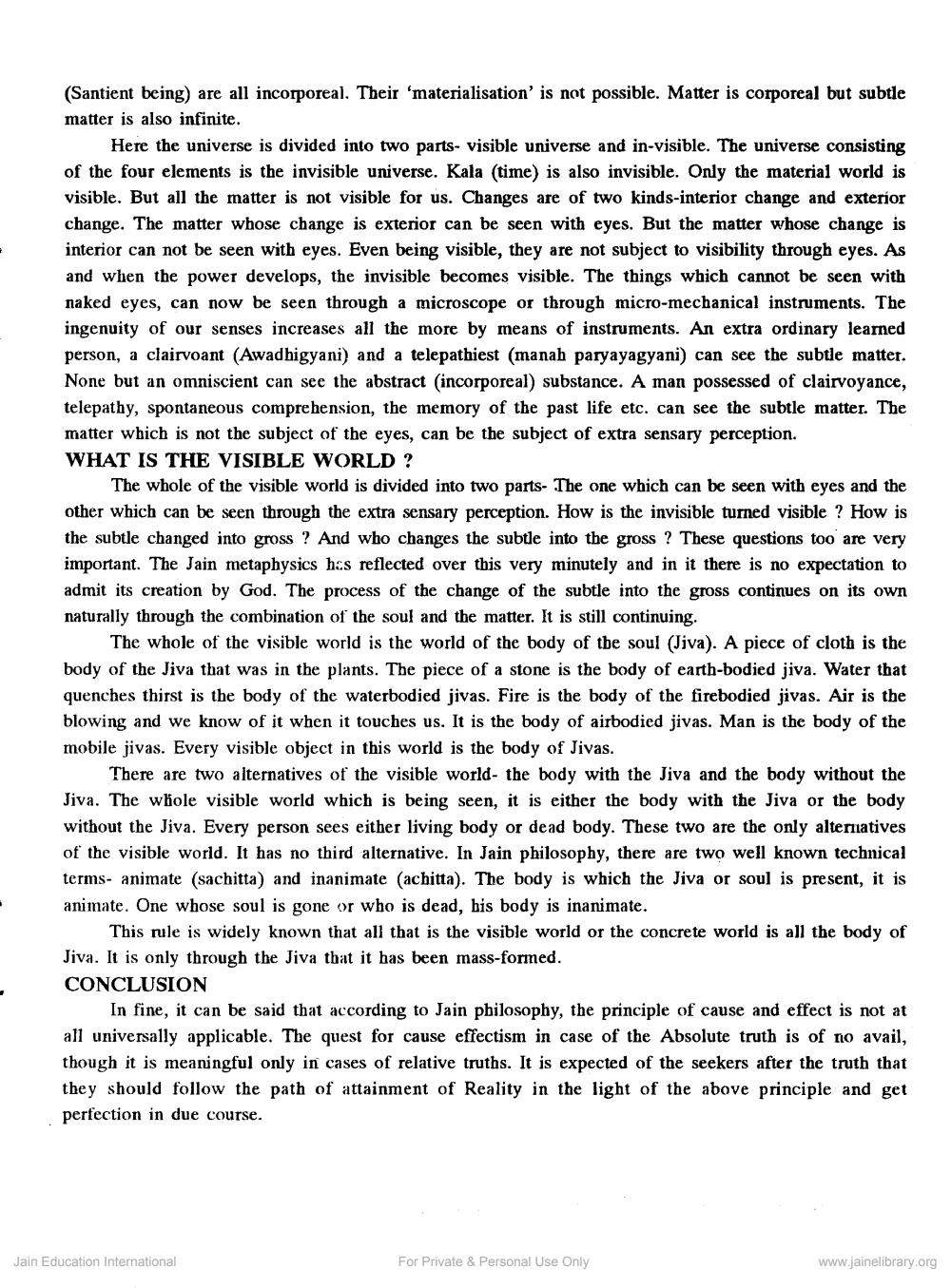________________
(Santient being) are all incorporeal. Their 'materialisation' is not possible. Matter is corporeal but subtle matter is also infinite.
Here the universe is divided into two parts- visible universe and in-visible. The universe consisting of the four elements is the invisible universe. Kala (time) is also invisible. Only the material world is visible. But all the matter is not visible for us. Changes are of two kinds-interior change and exterior change. The matter whose change is exterior can be seen with eyes. But the matter whose change is interior can not be seen with eyes. Even being visible, they are not subject to visibility through eyes. As and when the power develops, the invisible becomes visible. The things which cannot be seen with naked eyes, can now be seen through a microscope or through micro-mechanical instruments. The ingenuity of our senses increases all the more by means of instruments. An extra ordinary learned person, a clairvoant (Awadhigyani) and a telepathiest (manah paryayagyani) can see the subtle matter. None but an omniscient can see the abstract (incorporeal) substance. A man possessed of clairvoyance, telepathy, spontaneous comprehension, the memory of the past life etc. can see the subtle matter. The matter which is not the subject of the eyes, can be the subject of extra sensary perception. WHAT IS THE VISIBLE WORLD ?
The whole of the visible world is divided into two parts. The one which can be seen with eyes and the other which can be seen through the extra sensary perception. How is the invisible turned visible ? How is the subtle changed into gross? And who changes the subtle into the gross? These questions too are very important. The Jain metaphysics hcs reflected over this very minutely and in it there is no expectation to admit its creation by God. The process of the change of the subtle into the gross continues on its own naturally through the combination of the soul and the matter. It is still continuing.
The whole of the visible world is the world of the body of the soul (Jiva). A piece of cloth is the body of the Jiva that was in the plants. The piece of a stone is the body of earth-bodied jiva. Water that quenches thirst is the body of the waterbodied jivas. Fire is the body of the firebodied jivas. Air is the blowing and we know of it when it touches us. It is the body of airbodied jivas. Man is the body of the mobile jivas. Every visible object in this world is the body of Jivas.
There are two alternatives of the visible world- the body with the Jiva and the body without the Jiva. The whole visible world which is being seen, it is either the body with the Jiva or the body without the Jiva. Every person sees either living body or dead body. These two are the only alternatives of the visible world. It has no third alternative. In Jain philosophy, there are two well known technical terms- animate (sachitta) and inanimate (achitta). The body is which the Jiva or soul is present, it is animate. One whose soul is gone or who is dead, bis body is inanimate.
This rule is widely known that all that is the visible world or the concrete world is all the body of Jiva. It is only through the Jiva that it has been mass-formed. CONCLUSION
In fine, it can be said that according to Jain philosophy, the principle of cause and effect is not at all universally applicable. The quest for cause effectism in case of the Absolute truth is of no avail, though it is meaningful only in cases of relative truths. It is expected of the seekers after the truth that they should follow the path of attainment of Reality in the light of the above principle and get perfection in due course.
Jain Education International
For Private & Personal Use Only
www.jainelibrary.org




